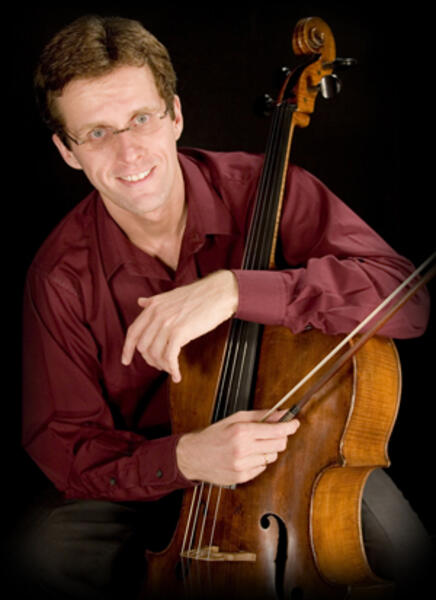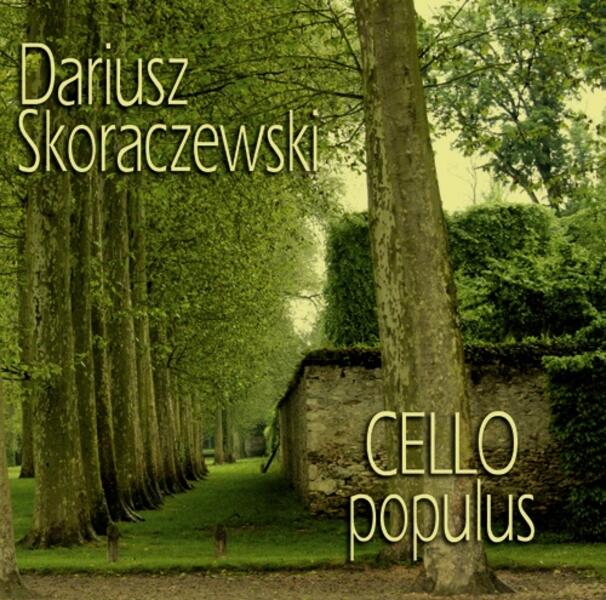Cello Populus (populus - latin for poplar and popular) is a collection of 20th and 21st century music for solo cello. Choosing the pieces for this album wasn't easy since there is plenty of good cello music out there, so I decided to pick compositions that in my opinion can truly connect with the listener in the same way that Mozart or Beethoven do. I believe that the material here will one day be as popular in the world's concert halls as the Bach's Cello Suites are. Included below are the beautifully written notes from the CD itself. I'd like to mention also that besides playing on the album, I also produced, engineered and edited the material.
Program notes by Rene Edmunds:
Solo cello recordings are traditionally avuncular, respectable affairs: the wide-ranging tenor voice of the string section allowed to rumble and coo on its lonesome for once. On this album, however, the listener is ushered in so closely to the instrument that all the glossed over details in typical cello recordings are laid bare. Plucked notes can sound downright thunderous. Overtones that are rarely heard ring as clearly as a bell. Normally, the only one who hears the instrument in this much detail is the cellist.
There is a sense of shared intimacy on Cello Populus, between the listener, the cellist and his instrument. The cellist is Polish-born Dariusz Skoraczewski who currently serves as Principal in the Baltimore Symphony Orchestra. The life of a full-time orchestral musician is a busy one, full of endless stream of notes, guest conductors and soloists. Dariusz set aside some time this past winter to record these pieces, and as he communes with his instrument, alone again, the magic of the cello reemerges. How could some shaped wood and strung metal, scraped with drawn hairs and bits of rosin be capable of such a galaxy of sound?
Many of the pieces on this album explore that very question. The oldest, at 83 year, is the Hindemith Sonata. Here, the cello is not deconstructed as in later pieces, but it is pushed squarely into realm of objectivity. In this sonata, the cello simply speaks for itself, with the wide ranging set of movements. There is an aria in the middle, followed by perpetual motion challenge, and an absolutely explosive plucked C# to finish the piece.
George Crumb wrote his Sonata when he was studying in Berlin on Fullbright fellowship in 1955. It begins in a melancholy mood. The strums of the instrument evoke a late-night creep through darkened streets. A five-note melody finally emerges before unspooling into a rambling monologue.
Crumb clears the paranoid air with a rustic theme and its set of three variations. The sonata culminates in a dazzling toccata, which opens in a hurried ascent to the upper reaches of the cello's chest voice, where the melody of the first movement reappears in a much more playful manner. Though the music never lightens entirely, it is significantly unburdened, a perfect warm up for the whimsy of the Polish Caprice.
Grazyna Bacewicz was a gifted performer on both the violin and piano. She wrote many short pieces, such as the Polish Caprice, as encores for her frequent recitals. Originally written for violin, Bacewicz arranged the Caprice for cello, and it begins with a melodic lament that evaporates into a lively dance.
The momentum of her Caprice is arrested by the opening grunt of Lutoslawski's Sacher Variation. The composer cobbles together the letters S-A-C-H-E-R in musical code through fits and starts. Paul Sacher was a champion of new music, and the Variation is Lutoslawski's response to Rostropovich'e commission for a piece honoring Sacher's 70th birthday. Lutoslawski pushes the cello out of its traditional comfort zone. Instead of sculpted melodies and rhythms, the instrument is tasked with ever more awkward gestures.
Penderecki's Divertimento picks up where Lutoslawski leaves off, pushing cellist and listener further out into foreign terrain. The Serenade begins in the manner of Crumb's Fantasia, but before the cellist can pluck the strings, he has to strike them with the back of his bow. As with Crumb, a simple melody appears, but it quickly becomes clear that Penderecki will not let it develop in the traditional way. The music accelerates and climbs culminating in whistling tones well into the cello's falsetto range. Penderecki climbs down from the novelty of this introduction, and the rest of the Divertimento recalls Hindemith's objectivity. Yet, Penderecki's cello strays further away from its normal idioms in each movement.
The newest piece on the program takes the freshest look at the cello. The great Finish composer Kaija Saariaho wrote Sept Papillons in 2000, and it thoroughly investigates the atmospheric potential of the instrument. A series of textures, rather than a conventional development of musical material, sept Papillons calls for the most extended technique of any of these pieces. Saariaho takes a microscope to the cello allowing the listener to examine the instrument's acoustic in glorious detail.
The final piece remained unperformed for almost three decades after Ligeti composed it in 1953. Split in two movements, his Sonata begins with an impish plucked glissando. The gesture seems like a wave goodbye to Saariaho's modernism. The lush melodies signal a coda to this retreat into the cello universe. There is a final nod to virtuosity in the brisk Capriccio. Then, the break from real life is over. The cellist's seat in the orchestra beckons.
Listening to Cello Populus with headphones reveals the full spectrum of its sounds. In these recordings, Dariusz has captured the secret inner life of the cello, its woody, spring-loaded nature. Experiencing the album is rather like a pause in a green forest clearing, listening ever closer to the abundance of sounds that are hidden while we are in motion. If you are just still enough, the trees themselves will speak to you.
Review by Mike D. Brownell - allmusic.com:
"Album liner notes that start off with effusive, self-laudatory praise raise eyebrows as they often do not deliver on their promises. In the case of this Analog Arts album, Cello Populus, cellist, producer, recording engineer, and editor Dariusz Skoraczewski actually does give listeners what he says: a solo cello album with staggeringly beautiful sound quality. Is it vastly superior quality to virtually every other such album available? Probably not, but Skoraczewski does have something special to offer in both his playing and his ear for recorded sound. Skoraczewski's program begins with the 1923 Hindemith Solo Sonata, Op. 25/3, and progresses through works from the last half of the 20th century by Bacewicz, Crumb, Ligeti, Penderecki, Lutoslawski, and Saariaho. In each case, Skoraczewski plays with remarkably precise technique: intonation, articulation, shifts, and dynamics are all superb. He also incorporates vivid, sweeping musical gestures that instantly grab the attention of the listeners as he guides them through what, for most, is largely unfamiliar literature. His tone is rich and dark on the lower strings, clear and penetrating in the higher registers, and is seamlessly connected between the two. Put together all of these attributes and the result is a truly exceptional album that leaves listeners eagerly waiting for another installment."
Program:
Paul Hindemith, Sonata for Cello Solo Op. 25, No. 3 (1923)
George Crumb, Sonata for Cello Solo (1955)
Grazyna Bacewicz, Polish Caprice for Cello Solo (1949)
Witold Lutoslawski, Sacher Variation for Cello Solo (1975)
Krzysztof Penderecki, Divertimento for Cello Solo (1994)
Kaija Saariaho, Sept Papillons for Cello Solo (2000)
Gyorgy Ligeti, Sonata for Cello Solo (1953)
Program notes by Rene Edmunds:
Solo cello recordings are traditionally avuncular, respectable affairs: the wide-ranging tenor voice of the string section allowed to rumble and coo on its lonesome for once. On this album, however, the listener is ushered in so closely to the instrument that all the glossed over details in typical cello recordings are laid bare. Plucked notes can sound downright thunderous. Overtones that are rarely heard ring as clearly as a bell. Normally, the only one who hears the instrument in this much detail is the cellist.
There is a sense of shared intimacy on Cello Populus, between the listener, the cellist and his instrument. The cellist is Polish-born Dariusz Skoraczewski who currently serves as Principal in the Baltimore Symphony Orchestra. The life of a full-time orchestral musician is a busy one, full of endless stream of notes, guest conductors and soloists. Dariusz set aside some time this past winter to record these pieces, and as he communes with his instrument, alone again, the magic of the cello reemerges. How could some shaped wood and strung metal, scraped with drawn hairs and bits of rosin be capable of such a galaxy of sound?
Many of the pieces on this album explore that very question. The oldest, at 83 year, is the Hindemith Sonata. Here, the cello is not deconstructed as in later pieces, but it is pushed squarely into realm of objectivity. In this sonata, the cello simply speaks for itself, with the wide ranging set of movements. There is an aria in the middle, followed by perpetual motion challenge, and an absolutely explosive plucked C# to finish the piece.
George Crumb wrote his Sonata when he was studying in Berlin on Fullbright fellowship in 1955. It begins in a melancholy mood. The strums of the instrument evoke a late-night creep through darkened streets. A five-note melody finally emerges before unspooling into a rambling monologue.
Crumb clears the paranoid air with a rustic theme and its set of three variations. The sonata culminates in a dazzling toccata, which opens in a hurried ascent to the upper reaches of the cello's chest voice, where the melody of the first movement reappears in a much more playful manner. Though the music never lightens entirely, it is significantly unburdened, a perfect warm up for the whimsy of the Polish Caprice.
Grazyna Bacewicz was a gifted performer on both the violin and piano. She wrote many short pieces, such as the Polish Caprice, as encores for her frequent recitals. Originally written for violin, Bacewicz arranged the Caprice for cello, and it begins with a melodic lament that evaporates into a lively dance.
The momentum of her Caprice is arrested by the opening grunt of Lutoslawski's Sacher Variation. The composer cobbles together the letters S-A-C-H-E-R in musical code through fits and starts. Paul Sacher was a champion of new music, and the Variation is Lutoslawski's response to Rostropovich'e commission for a piece honoring Sacher's 70th birthday. Lutoslawski pushes the cello out of its traditional comfort zone. Instead of sculpted melodies and rhythms, the instrument is tasked with ever more awkward gestures.
Penderecki's Divertimento picks up where Lutoslawski leaves off, pushing cellist and listener further out into foreign terrain. The Serenade begins in the manner of Crumb's Fantasia, but before the cellist can pluck the strings, he has to strike them with the back of his bow. As with Crumb, a simple melody appears, but it quickly becomes clear that Penderecki will not let it develop in the traditional way. The music accelerates and climbs culminating in whistling tones well into the cello's falsetto range. Penderecki climbs down from the novelty of this introduction, and the rest of the Divertimento recalls Hindemith's objectivity. Yet, Penderecki's cello strays further away from its normal idioms in each movement.
The newest piece on the program takes the freshest look at the cello. The great Finish composer Kaija Saariaho wrote Sept Papillons in 2000, and it thoroughly investigates the atmospheric potential of the instrument. A series of textures, rather than a conventional development of musical material, sept Papillons calls for the most extended technique of any of these pieces. Saariaho takes a microscope to the cello allowing the listener to examine the instrument's acoustic in glorious detail.
The final piece remained unperformed for almost three decades after Ligeti composed it in 1953. Split in two movements, his Sonata begins with an impish plucked glissando. The gesture seems like a wave goodbye to Saariaho's modernism. The lush melodies signal a coda to this retreat into the cello universe. There is a final nod to virtuosity in the brisk Capriccio. Then, the break from real life is over. The cellist's seat in the orchestra beckons.
Listening to Cello Populus with headphones reveals the full spectrum of its sounds. In these recordings, Dariusz has captured the secret inner life of the cello, its woody, spring-loaded nature. Experiencing the album is rather like a pause in a green forest clearing, listening ever closer to the abundance of sounds that are hidden while we are in motion. If you are just still enough, the trees themselves will speak to you.
Review by Mike D. Brownell - allmusic.com:
"Album liner notes that start off with effusive, self-laudatory praise raise eyebrows as they often do not deliver on their promises. In the case of this Analog Arts album, Cello Populus, cellist, producer, recording engineer, and editor Dariusz Skoraczewski actually does give listeners what he says: a solo cello album with staggeringly beautiful sound quality. Is it vastly superior quality to virtually every other such album available? Probably not, but Skoraczewski does have something special to offer in both his playing and his ear for recorded sound. Skoraczewski's program begins with the 1923 Hindemith Solo Sonata, Op. 25/3, and progresses through works from the last half of the 20th century by Bacewicz, Crumb, Ligeti, Penderecki, Lutoslawski, and Saariaho. In each case, Skoraczewski plays with remarkably precise technique: intonation, articulation, shifts, and dynamics are all superb. He also incorporates vivid, sweeping musical gestures that instantly grab the attention of the listeners as he guides them through what, for most, is largely unfamiliar literature. His tone is rich and dark on the lower strings, clear and penetrating in the higher registers, and is seamlessly connected between the two. Put together all of these attributes and the result is a truly exceptional album that leaves listeners eagerly waiting for another installment."
Program:
Paul Hindemith, Sonata for Cello Solo Op. 25, No. 3 (1923)
George Crumb, Sonata for Cello Solo (1955)
Grazyna Bacewicz, Polish Caprice for Cello Solo (1949)
Witold Lutoslawski, Sacher Variation for Cello Solo (1975)
Krzysztof Penderecki, Divertimento for Cello Solo (1994)
Kaija Saariaho, Sept Papillons for Cello Solo (2000)
Gyorgy Ligeti, Sonata for Cello Solo (1953)
-
Paul Hindemith - Sonata for Cello Solo, op.25, no.31.Lebhaft, sehr markiert 2. Massig schnell, gemachlich 3. Langsam 4. Lebhafte Viertel 5. Massig schnell
-
George Crumb - Sonata for cello Solo1. Fantasia 2. Tema Pastorale con Variazioni 3. Toccata
-
Grażyna Bacewicz - Polish Caprice for Cello Solo
-
Witold LutosÅ?awski - Sacher Variation for Cello Solo
-
Krzysztof Penderecki - Divertimento for cello solo1. Serenade 2. Scherzo 3. Notturno 4. Sarabande - J.S.B. in memoriam 5. Tempo di valse
-
Kaija Saariaho - Sept papillons for cello solo1. Papillon I Dolce, leggiero, libero 2. Papillon II Leggiero, molto expressivo 3. Papillon III Calmo, con tristezza 4. Papillon IV Dolce, tranquillo 5. Papillon V Lento, misterioso 6. Papillon VI Sempre poco nervoso 7. Papillon VII Molto espressivo, energico
-
Gyorgy Ligety - Sonata for Cello SoloDialogo - Adagio, rubato, cantabile
-
Gyorgy Ligeti - Sonata for Cello SoloCapriccio-Presto con slacio
-
 Photo by Christian Colberg
Photo by Christian Colberg -
 CD CoverPoplar trees in Versailles. Photo by Pei Lu
CD CoverPoplar trees in Versailles. Photo by Pei Lu


